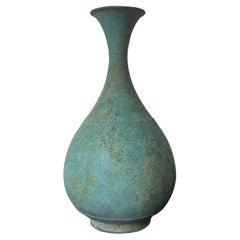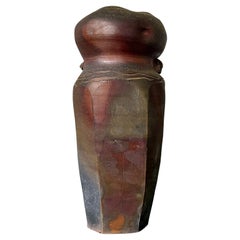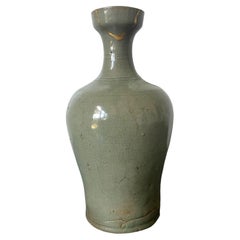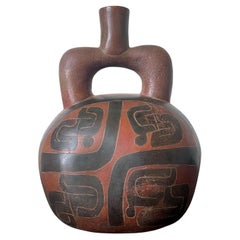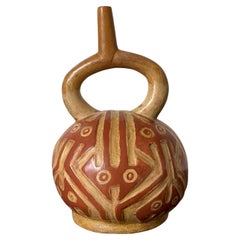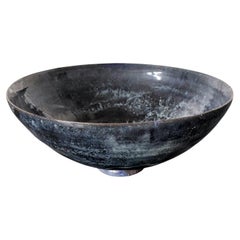TISHU Vases and Vessels
to
1
117
17
25
21
71
17
27
7
30
6
2
1
1
3
3
6
4
45
1
1
122
7
6
5
5
134
89
89
62
29
29
Height
to
Width
to
134
134
134
17
7
4
4
3
Korean Bronze Bottle Goryeo Dynasty
Located in Atlanta, GA
An antique Korean bronze bottle of bulbous pear form with a long neck and flared open mouth from Goryeo Dynasty (918 AD-1392 AD) circa 12-13th century I...
Category
Antique 15th Century and Earlier Korean Archaistic Bottles
Materials
Bronze
Wood-Fired Ceramic Vase by Paul Chaleff
By Paul Chaleff
Located in Atlanta, GA
A stoneware vase by Paul Chaleff (1947-) made in 1984. Chaleff is known for his wood fired ceramic vessel without glaze or sometimes natural ash glaze. The vase on offer is of a highly geometrical form with handcut multifaceted lower body that rises and morphs into a rounded upper body with two hand-molded ears above the shoulder. The surface shows nice firing color variations due to the iron oxidation in the kiln and also carved lines left intentionally by the artist. It is marked with the artist's incised signature and date 84. This piece has a very strong Japanese wabi-sabi appeal which is the aesthetic influence of the artist's work and makes a visually arresting center piece for any interior.
"Paul Chaleff is known for his large-scale wood fired ceramic sculptures and vessels. He also created a large body of wheel thrown functional vessels. His vessels are strongly influenced by Japanese pottery, especially the work of one of Japan’s National Living Treasures, Takeshi Nakazato. Chaleff was one of the first American potters using a Japanese style Anagama kiln and became a leader in the introduction of this form of wood-burning kiln.
In 1989, he began a regular collaboration with the British sculptor Sir Anthony Caro. Over a period of thirteen years, they created nearly 50 works, both figurative and abstract. Caro’s sculpture has had direct influence on Chaleff’s work as has the sculpture of Isamu Noguchi, and the ceramics of John Mason...
Category
Vintage 1980s American Modern Jars
Materials
Ceramic
Korean Caledon Vase Bottle with Kintsugi Repair Goryeo Dynasty
Located in Atlanta, GA
A ceramic wide-mouthed bottle vase covered in green celadon glaze from Goryeo dynasty circa 11-12th century. The bottle vase with such a form (mouth with wide rim, long and slender neck, tall body with swelled shoulders that taper down toward the base) is known as "kwanggubyong" in Korean and developed from the prototype of bottles from united Silla kingdom. It was used for holding oil or liquid. Some of this type of vase take a plain form without much decoration other than glaze; Some feature basic geometrical lines, such as this one. Three concentric rings were featured along the neck and on the shoulder. Some with more carving on the body (see a vase in the collection of Brooklyn Musuem, 79.246.3) or a simple paint with iron glaze (See c.16-1930 in Fitzwilliam Musuem, Cambridge, UK).
The vase on offer is covered in a lovely green celadon glaze which exhibits fine even crackles throughout the surface. It has a slightly uneven base with the foot ring shaved by the potter. The surface is original with a nice mellow patina. There is a historical kintsugi repair on the mouth rim, with its gold vain...
Category
Antique 15th Century and Earlier Korean Archaistic Ceramics
Materials
Ceramic
Pre-Columbian Cupisnique Stirrup Vessel from Peru
Located in Atlanta, GA
A pre-Columbian ceramic stirrup vessel in Cupisnique style circa 700-500BCE. This ancient vessel features a robust squatted body and a short thick stirr...
Category
Antique 15th Century and Earlier Peruvian Pre-Columbian Tribal Art
Materials
Ceramic
Pre-Columbian Stirrup Vessel from Moche Culture
Located in Atlanta, GA
A ceramic stirrup vessel pot from late Moche culture circa 500-700AD in nowadays Northern Coast of Peru.
The hollow vessel features a rounded body and...
Category
Antique 15th Century and Earlier Peruvian Pre-Columbian Jars
Materials
Ceramic
Ceramic Bowl with Expressive Glaze by Beatrice Wood
By Beatrice Wood
Located in Atlanta, GA
A ceramic bowl by American artist and studio potter Beatrice Wood (1893-1998). The elegant bowl has a deep half-hemisphere form that is supported by a sho...
Category
Late 20th Century American Modern Vases
Materials
Ceramic
Modern Japanese Studio Pottery Oribe Tea Pot by Ken Matsuzaki
By Ken Matsuzaki
Located in Atlanta, GA
A contemporary studio ceramic tea pot with metal handle made by Japanese potter Ken Matsuzaki (1950-). The stoneware tea pot showcases a thick dripping Oribe green glaze partially revealing the unglazed part of the body, which is decorated with scrolling pattern of ash glaze. The work is rooted in both Yohen Shino glaze technique and Oribe tradition, but interestingly it also paid homage to Sancai pottery...
Category
Early 2000s Japanese Modern Ceramics
Materials
Ceramic
Ceramic Vase Royal Doulton Chang Ware
By Royal Doulton
Located in Atlanta, GA
A glazed ceramic vase in slender spindle form from the Chang Ware series by Royal Doulton (England, founded 1815) circa 1920-30s. The vase was decorated with thick and dripping glaze in rich mottled polychrome colors. The glaze shows overall irregular crackles, a signature characteristic of Chang Ware. The base is hand-marked "NOKE", Royal Doulton in rectangle and initial HN (for Harry Nixon).
Developed by Charles J. Noke (1858-1941), Doulton's Art Director, as part of his experimentation into Chinese flambé glazes during the 1920s. Fired at very high temperatures, they were introduced commercially by Doulton in 1925 in response to popular demand for eastern style ceramics. They were applied primarily by Harry Nixon (1886-1955). The name Chang Ware was used by Doulton in reference to the possibly mythical Song potter, Chang the Elder, although it bears little relationship to Song ceramics.
Category
Vintage 1920s English Modern Vases
Materials
Ceramic
Collection of Four Chinese Ceramic Vases with Peachbloom Glaze
Located in Atlanta, GA
An American Midwest collection of four small Chinese ceramic vases covered in peach-bloom glaze circa Qing Dynasty, 19th century, possibly earlier. The set consists of three vases of...
Category
Antique 19th Century Chinese Qing Ceramics
Materials
Ceramic
Pre-Columbian Black Figural Stirrup Vessel Moche Culture
Located in Atlanta, GA
A small black ceramic figural stirrup vessel from Moche culture circa. 100-500 AD, located in nowadays Northern Coast of Peru. The hollow pot with the stirrup handle was sensitively molded and the surface burnished. The seated figure has his arms folded in front of his chest. He has prominently protruding ears and an expressive face.
Provenance Available to the buyer: From an American collection.
For a black burnished stirrup bottle, see item 1976.287.8, 64.228.35 in the collection of Metropolitan Musuem of Art, NYC.
Many black portrait stirrup bottles are in the collection of Larco Musuem, Lima...
Category
Antique 15th Century and Earlier Peruvian Pre-Columbian Bottles
Materials
Ceramic
Ceramic Vase with Green Glaze by John Ward
By John Ward
Located in Atlanta, GA
A stoneware vessel by British studio ceramist John Ward (1938-2023) circa 1985. The flat shouldered vase is molded in a simple and elegant form with harmonious proportion. A small mo...
Category
Vintage 1980s English Organic Modern Vases
Materials
Ceramic
Fine Japanese Ceramic Satsuma Vase by Kinkozan
By Kinkozan
Located in Atlanta, GA
A miniature Japanese ceramic vase from the end of Meiji period circa 1880s- 1910s by Kinkozan (1645-1927). One of the largest studio manufacturers of the export ceramics at the time ...
Category
Early 20th Century Japanese Meiji Ceramics
Materials
Ceramic
Korean Glazed Ceramic Vase Buncheong Ware Joseon Dynasty
Located in Atlanta, GA
A small antique Korean Buncheong stoneware vase from early Joseon Dynasty circa 16th century. The vase is of a classic pear form with a waisted neck, a flared mouth and a ringed base...
Category
Antique 16th Century Korean Other Ceramics
Materials
Ceramic
Japanese Porcelain Vase Makuzu Kozan Meiji Period
By Makuzu Kozan
Located in Atlanta, GA
A striking blue and white vase from the studio of Japanese Potter Makuzu Kozan, also known as Miyagawa Kozan (1842–1916), one of the most established and collected ceramist from Meiji Period. Born as Miyagawa Toranosuke, Kozan established his pottery studio in Yokohama circa 1870s and later became one of the appointed artists to the Japanese Imperial household. His work was exhibited in many international fairs that the Meiji government participated at the turn of the century and won many grand prizes.
Of a relatively large size, this vase is decorated with underglaze cobalt blue using the novel technique developed by Kozan called Fuki-e (the blow painting). As a result, the bamboos appear took on a three-dimensional quality as if appearing in a mist. Known as one of the most creative ceramists, circa 1887, Kozan started experimenting with new chemical colors from the West in the format of his porcelain glaze. New colors allowed him to create underglaze design that appeared bright, smooth and glossy. He even invented his own receipt of cobalt blue to achieve a much brighter yet softer shade, as evident on this vase. To create landscape that is realistic and dimensional, more common in the western paintings, he was inspired by the native Japanese ink painting technique developed around 1900 by Yokoyama Taikan...
Category
Antique Early 1900s Japanese Japonisme Ceramics
Materials
Ceramic
